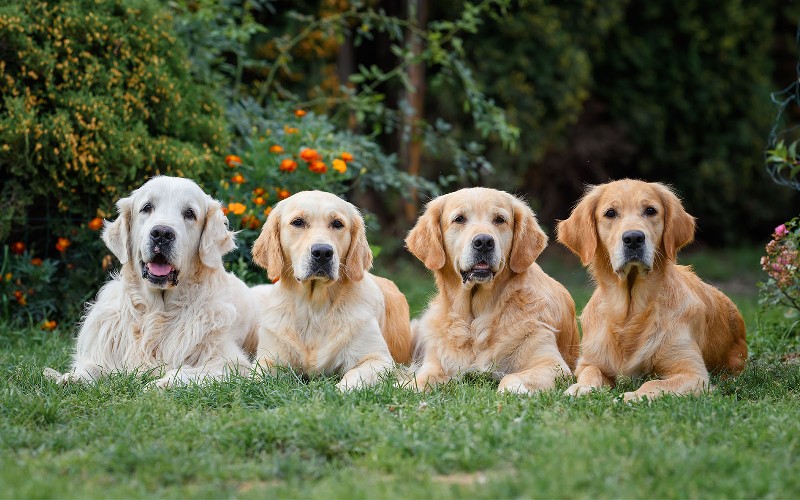
What Affects Your Dog’s Fur Color? Genetics, Diet, and Care Explained
Ever wondered why your dog’s fur has a specific color or why some dogs sport striking patterns while others have a solid coat? Just like in humans, a dog's fur color is largely influenced by genetics, passed down from their parents, and plays a key role in defining their unique coat.The exact color or pattern depends on the type and amount of melanin that passes into the bulb to the hair.
Two main pigments, which are forms of melanin, are responsible for the color of the fur: Eumelanin, responsible for black or brown hues, and Pheomelanin, responsible for red or yellow hues.
All color variations are created by the combination of these two pigments. The range of colors spans from pure black to various shades of brown, red, and yellow. The color white instead is determined by the lack of melanin in the hair.
White color should not be confused with albinism, which is a condition that involves the inability to synthesize melanin. The pigment in this case is not present in either the hair or the skin.
However, some external factors can alter the natural pigmentation of a dog’s coat, including, ultraviolet rays from the sun, staining factors, some pathologies such as the aforementioned albinism or inflammations, and other external factors such as imbalanced nutrition can lead to the staining or discoloration of fur.
The Role of Diet in Fur Color
While genetics set the base for a dog's coat color, what they eat can affect their fur color.
Here's how:
Amino Acids: both eumelanin and pheomelanin come from the amino acid tyrosine, which plays a crucial role in stimulating the production of melanin. Tyrosine can be produced in the body from another amino acid called phenylalanine or taken directly from food. A balanced diet rich in quality proteins ensures an adequate supply of tyrosine. Diets deficient in tyrosine or containing low-quality proteins may interfere with melanin production, potentially altering coat color and leading to a progressive reddish discoloration of the coat, as proven in some scientific studies.
Besides amino acids, there are other nutrients involved in this process:
- Copper: a vital metal needed for tyrosinase; the main enzyme involved in the production of melanin.
- Omega-3 fatty acids: Omega-3 fatty acids have anti-inflammatory effects, which means that adding high-quality omega-3 sources such as fish oil to a dog’s diet can contrast the inflammations at the base of hair staining.
How Diet Can Change Coat Colors
Research has shown that increasing the intake of tyrosine and phenylalanine in the diet can make brown coats richer and more vivid.
Specifically, findings in puppies demonstrated that increasing tyrosine and phenylalanine intake enhanced black pigmentation in Labrador Retrievers and Newfoundlands. Another study with black Labrador Retrievers found that dogs with higher levels of these amino acids had more intense black coats and less fading to yellow or red.
An intriguing anomaly in canine coat color, particularly observed in white breeds, is the occasional development of reddish or yellowish hues. This phenomenon has been tentatively linked to seasonal changes, shedding, and grooming practices, though direct scientific evidence remains limited. Nutrition also emerges as a potential contributing factor.
A study on Swiss White Shepherds found that dogs fed with reduced levels of tyrosine and phenylalanine, and copper showed significantly less red coat pigmentation by the end of the feeding study. This shows that diet can therefore exert an influence on multiple aspects of coat pigmentation.
N&D White and N&D Brown: Farmina’s Solutions for a Soft and Shiny Coat
Understanding the significant influence of nutrition on coat pigmentation in dogs, Farmina has formulated two specific products tailored to meet the diverse needs of dogs with various coat colors and textures, ensuring they receive optimal nutrition: N&D White and N&D Brown. With careful ingredient selection, we minimize the risk of depigmentation in dark coats and mitigate pigmentation issues in white ones, promoting both a healthier appearance and well-being.
N&D White is specifically designed to prevent staining in white coats. Formulated with single animal proteins of high biological value (to minimize the risk of adverse food reaction), limited levels of phenylalanine and tyrosine, limited copper content, and omega-3 fatty acids. Ideal for small white breeds like West Highland/White Terrier, Maltese, Pomeranian, Poodle, and Bull Terrier, as well as small dogs with white fur.
N&D Brown is formulated to prevent discoloration in dark coats; this line features high biological value proteins, elevated levels of phenylalanine and tyrosine, adequate copper, and omega-3 fatty acids. Perfect for small brown breeds such as Chihuahua, Schnauzer, French Bulldog, Pinscher, Poodle, and small dogs with brown fur.
Find the best solution for your white or brown dog!
Learn More

